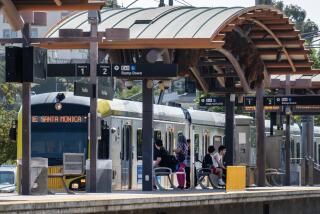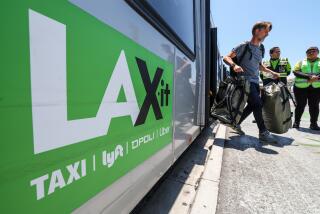Emergency Ride Service Helping, Officials Report
One woman had to rush home in the middle of the day to attend to a sick child.
In another instance, a worker had to stay late at his boss’ insistence to finish up a report. And in a third case, a man had to leave his job early because of a family emergency.
All either used car pools or public transit to commute to work and would have been stranded if not for Ventura County’s Guaranteed Ride Home program.
Although plans for the program were criticized by opponents who deemed the service unnecessary and ripe for abuse, county transportation officials said they are pleased with the response since the program was launched 1 1/2 years ago. In fact, they said other communities are already looking at the program as a model to help solve their traffic problems.
Since its inception in September 1997, the ride program has signed up more than 5,800 potential users at 146 work sites in Ventura County. As of last month, it had provided 164 emergency rides at a total cost of $5,000, about $30 a ride.
“Of course, we’d like to see more people sign up to use it, but we’re very happy with the success we’ve had so far,” said Mary Travis, manager of rail and regional programs for the Ventura County Transportation Commission.
The program has been funded for three years with $75,000 in state and federal transportation monies. It has also been embraced by the county’s PRIDE “Welfare to Work” initiative as a means of providing commuting guarantees to welfare recipients just entering the work force or attending job-training courses.
Other transportation authorities, like those in Broward County, Fla., and Connecticut, are considering services modeled after the ride program.
“Historically, when you have these kinds of guarantees, commuters are more comfortable using ride-share, which in itself has enormous benefits for communities and cities that are growing,” said Alan Holmes of the Southern California Assn. of Governments, which helped start the county’s program.
But what impact Ventura County’s program has had in persuading more motorists to carpool or to take the bus remains unclear. “There was some concern that people would get one of the rented cars and think, ‘This is pretty comfortable’ and keep using it,” Travis said. “But I think we’ve taken care of that concern and there haven’t been any problems.”
Residents enrolled in the program are only allowed to use the service in an emergency.
Participants are only allowed to use the service twice per month. Travis said she is not aware of anyone who has used it more than once.
But whether the county ever needed such a service continues to be a matter of debate.
According to government association’s 1996 “State of the Commute” report, 80% of Ventura County commuters drive alone to work each day, and of those polled, only 23% were aware of bus availability--the lowest percentage in the six-county Southern California region.
In the coming year, the commission will begin advertising the Guaranteed Ride Home program at movie theaters. It also has begun to approach companies to organize registration drives.
More to Read
Sign up for Essential California
The most important California stories and recommendations in your inbox every morning.
You may occasionally receive promotional content from the Los Angeles Times.










